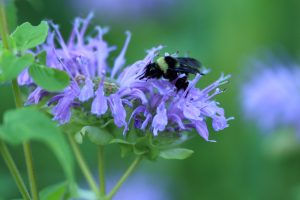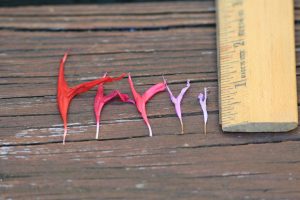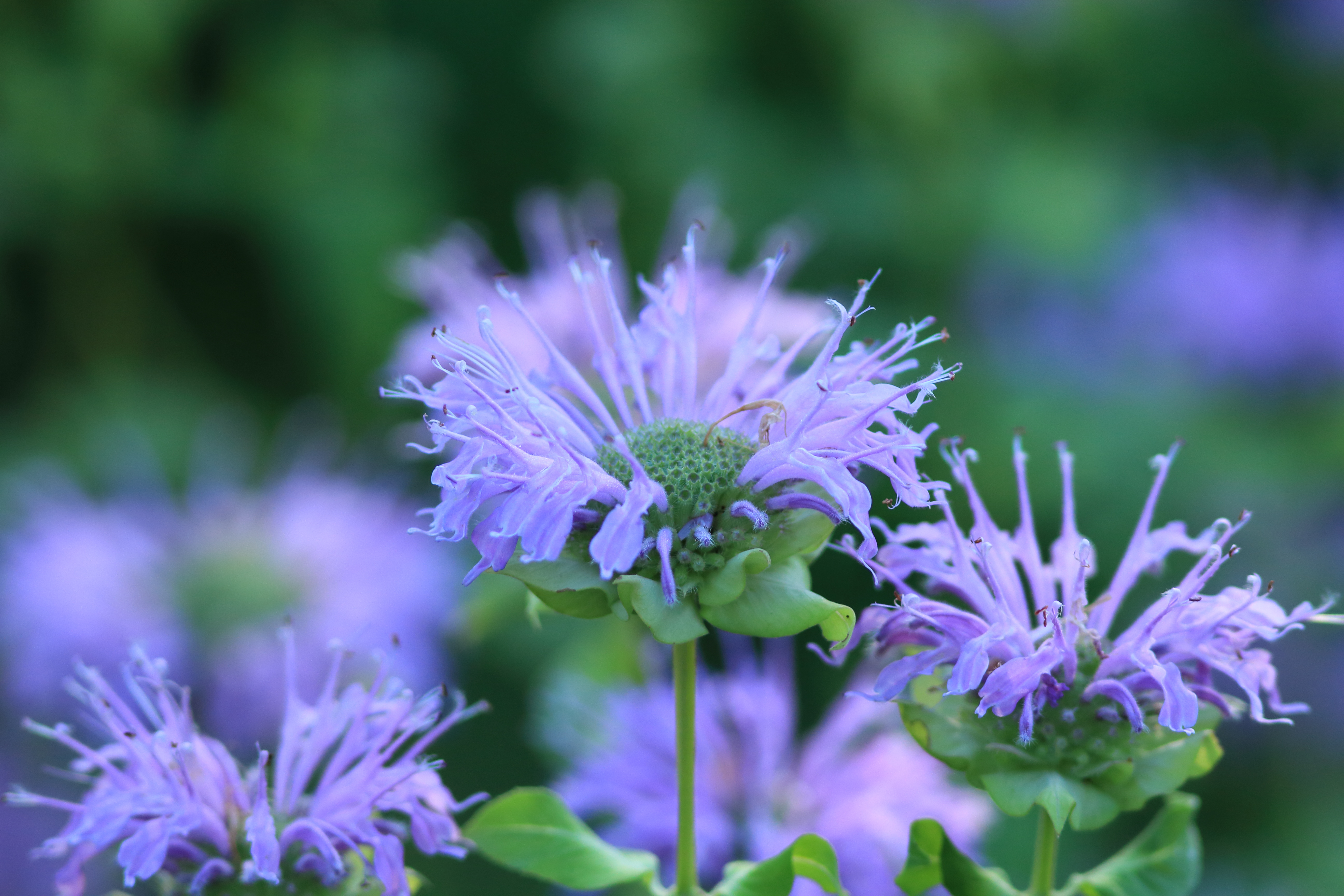In our yard, we have planted native species to attract pollinators. Two species of Monarda are native to our part of the world—Monarda didyma and Monarda fistulosa and both can be found in our yard.

Today, I strolled through our garden and noticed how we actually have four different colors of Monarda—a deep red M. didyma, and three varieties of M. fistulosa, a very pale blue, a blue, and a purplish red.
So far, I used the scientific name for these two plants. Each species has multiple common names. Monarda didyma is known as scarlet bee balm (the name preferred by the United Sates Department of Agriculture), Oswego tea, fragrantbalm, and mountain-mint.

Monarda fistulosa is called wild bergamot (the name preferred by the United Sates Department of Agriculture), mintleaf beebalm, horse-mint, and purple beebalm. The abundance of common names does two things: create confusion as to a plants true identity and indicates that the plant was of interest historically. Several years ago, I became totally engrossed by these plants. I researched the origin of each name. Why is the red one called bee balm? What is the origin of Oswago tea? Why is the blue one wild bergamot? After days and days of research, I finished with more questions than answers. I will save you the details.

Today, I noticed how the blue and purple flowers, the varieties of M. fistulosa, attracted numerous bumblebees, but saw none approach the scarlet bee balm.

 So, I randomly plucked a single flower (corolla) from each type of Monarda in our yard, laid them side by side from scarlet to pale blue and with a ruler to check out the difference. It is very obvious that the length of the corollas vary greatly based upon the color and type.
So, I randomly plucked a single flower (corolla) from each type of Monarda in our yard, laid them side by side from scarlet to pale blue and with a ruler to check out the difference. It is very obvious that the length of the corollas vary greatly based upon the color and type.
The length of the red corolla was two inches (50 mm) long and one and a quarter inch (30 mm) from the mouth of the tube to the connection to the flower head, the location of the nectary.
The blue corolla (second from right) stretched one and a quarter inch in overall length and just three quarters of an inch for the tube length.
This explains why I could not find a bumblebee on the scarlet bee balm; they don’t like it.
 The length of the red tube, the placement of the anthers and stigma of the flowers, the quantity and availability of the nectar are perfectly aligned with the ruby-throated hummingbird physical body—beak (about 2/3 inch or 15 to 21 mm) with a tongue that sticks out as long as the bill one can see the tongue is just long enough to tap the nectar and the forehead is aligned perfectly to brush against the flowers sexual organs. The bee’s tongue is too short. Hence my confusion with the common name of scarlet bee balm.
The length of the red tube, the placement of the anthers and stigma of the flowers, the quantity and availability of the nectar are perfectly aligned with the ruby-throated hummingbird physical body—beak (about 2/3 inch or 15 to 21 mm) with a tongue that sticks out as long as the bill one can see the tongue is just long enough to tap the nectar and the forehead is aligned perfectly to brush against the flowers sexual organs. The bee’s tongue is too short. Hence my confusion with the common name of scarlet bee balm.
We encourage all of the colors, but I must admit, I favor the scarlet bee balm because it brings hummingbirds to our yard.
Reference:


On wow, Bob!!!! Your photography is stunning!! Thanks for those observations. We, too, have embarked on natives, (since you let me in on the secret), and the variety of insects dazzles me everyday. How do they know where to find us?? Where were they when we were planting chrysanthemums, petunias and other non-natives? Thank you for this informative post.
Glad to hear you are shifting to natives.
I live in an area on the far western fringe of Monarda fistulosa’s range and it does occur in specific places at the nature center where I formerly worked. I was always excited to see it.
Monarda didyma doesn’t occur naturally in my area but I was able to buy one at our local nursery to try. It’s been super for attracting hummers so far. I planted it in a big pot instead of in the ground so I could better control its care. I plan to leave it to winter in the pot so we’ll see if it survives to feed hummers another year!
Thanks for your post, Bob.
It is okay to deadhead, but make sure some flowers go to seed.